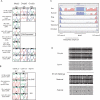A screen for retrotransposed imprinted genes reveals an association between X chromosome homology and maternal germ-line methylation
- PMID: 17291163
- PMCID: PMC1796624
- DOI: 10.1371/journal.pgen.0030020
A screen for retrotransposed imprinted genes reveals an association between X chromosome homology and maternal germ-line methylation
Abstract
Imprinted genes undergo epigenetic modifications during gametogenesis, which lead to transcriptional silencing of either the maternally or the paternally derived allele in the subsequent generation. Previous work has suggested an association between imprinting and the products of retrotransposition, but the nature of this link is not well defined. In the mouse, three imprinted genes have been described that originated by retrotransposition and overlap CpG islands which undergo methylation during oogenesis. Nap1l5, U2af1-rs1, and Inpp5f_v2 are likely to encode proteins and share two additional genetic properties: they are located within introns of host transcripts and are derived from parental genes on the X chromosome. Using these sequence features alone, we identified Mcts2, a novel candidate imprinted retrogene on mouse Chromosome 2. Mcts2 has been validated as imprinted by demonstrating that it is paternally expressed and undergoes promoter methylation during oogenesis. The orthologous human retrogenes NAP1L5, INPP5F_V2, and MCTS2 are also shown to be paternally expressed, thus delineating novel imprinted loci on human Chromosomes 4, 10, and 20. The striking correlation between imprinting and X chromosome provenance suggests that retrotransposed elements with homology to the X chromosome can be selectively targeted for methylation during mammalian oogenesis.
Conflict of interest statement
Competing interests. The authors have declared that no competing interests exist.
Figures





References
-
- Li E, Beard C, Jaenisch R. Role for DNA methylation in genomic imprinting. Nature. 1993;366:362–365. - PubMed
-
- Walsh CP, Chaillet JR, Bestor TH. Transcription of IAP endogenous retroviruses is constrained by cytosine methylation. Nat Genet. 1998;20:116–117. - PubMed
-
- Bourc'his D, Bestor TH. Meiotic catastrophe and retrotransposon reactivation in male germ cells lacking Dnmt3L. Nature. 2004;431:96–99. - PubMed
-
- Barlow DP. Methylation and imprinting: From host defense to gene regulation? Science. 1993;260:309–310. - PubMed
-
- Yoder JA, Walsh C, Bestor TH. Cytosine methylation and the ecology of intragenomic parasites. Nat Genet. 1997;13:335–340. - PubMed
Publication types
MeSH terms
Substances
Associated data
- Actions
- Actions
- Actions
- Actions
- Actions
- Actions
- Actions
- Actions
- Actions
- Actions
- Actions
- Actions
- Actions
Grants and funding
LinkOut - more resources
Full Text Sources
Other Literature Sources
Molecular Biology Databases

